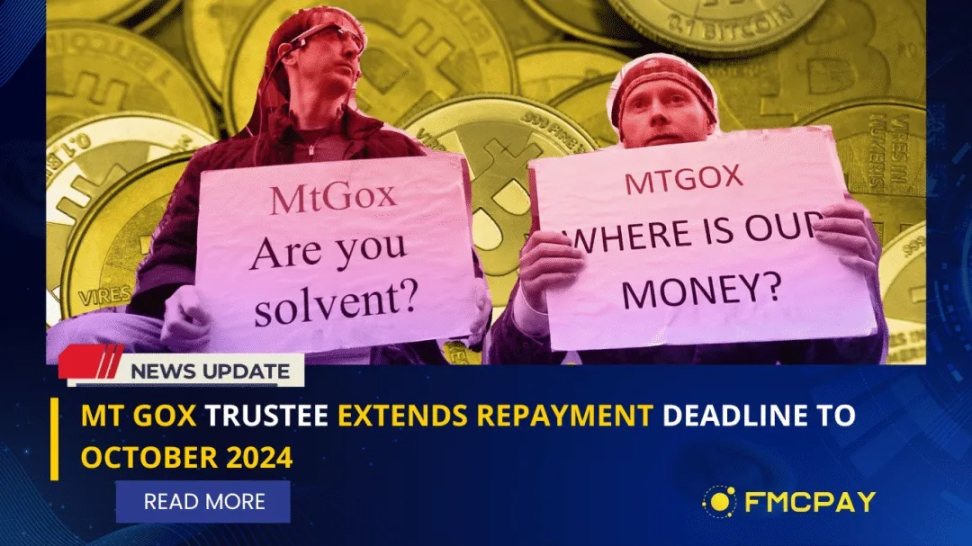Galaxy Research Director: Mt. Goxs repayment will not have much impact on Bitcoin price
Video link: Why the Mt. Gox Repayments May Not Hurt the Bitcoin Price Much
Original translation: Peyton, SevenUp DAO
A decade and a half after filing for bankruptcy, Mt. Gox will finally release 142,000 bitcoins worth nearly $9 billion to creditors between July and October.
The market is concerned about the impact this event may have on the prglace of Bitcoin, but Galaxy head of research Alex Thorn explained why only a small portion of Bitcoin will be sold. He also discussed the impact of this reallocation on the market, the likelihood of success of an Ethereum ETF, and the chances of approval of the Solana ETF.

It is estimated that the amount of Bitcoin sold by creditors will be a small fraction
Laura Shin: After a decade and a half, Mt. Gox will finally begin disbursing payments to creditors starting in July and continuing through October. A total of 142,000 bitcoins worth nearly $9 billion will be repaid. The market is concerned that this could cause bitcoin prices to fall. However, you say it is unlikely that creditors will sell all of these bitcoins. What do you think will happen?

https://news.fmcpay.com/mt-gox-extends-repayment-october-2024.html
Alex Thorn: It’s been a long wait. This is a major event, comparable to the FTX crash. The last time I was on your show, you were covering the Sam Bankman-Fried trial, which seemed to be tied to the first major crash in crypto.
When considering the 142,000 bitcoins recovered, it’s important to note that this represents only about 15% of the amount lost. Bankruptcy proceedings, especially in foreign countries, are notoriously complex and private. Creditors have been required to open accounts at Bitgo, Kraken or Bitstamp to receive these coins, as well as the Bitcoin Cash generated by the 2017 fork.
Creditors had to set up these accounts and reconcile and mediate through the distribution channels. This process has now been completed and the distribution will begin in July. However, in order to get the early payment, creditors must accept a 10-11% discount, which means they will receive about 90% of the amount they are due.
If we estimate that 75% of creditors choose to be paid early, then approximately 106,000 coins are affected. After discounting, we are left with approximately 64,000 coins. Some of these coins are held by entities such as the Mt. Gox Claims Fund and Bitcoinica, leaving approximately 64,000 Bitcoins to be distributed among 20,000 individual creditors.
Most of these claim funds plan to physically deliver their Bitcoin holdings to their limited partners (LPs), who are likely to be high net worth Bitcoin investors. Due to Bitcoinica’s bankruptcy proceedings in New Zealand, they are unable to sell their Bitcoin holdings immediately. Therefore, the immediate selling pressure is reduced.
The 64,000 coins will be delivered to individual creditors, many of whom are early Bitcoin holders who may choose to hold rather than sell given the long-term holding commitment and the potential impact of large capital gains taxes.
Laura Shin: Your analysis suggests that the impact of this event on the market may not be as severe as expected.
Alex Thorn: Exactly. On the surface, it looks like a massive sell-off, but given the nature of the creditors and the potential tax consequences, it seems like the sell-off will be much less.
Bitcoin Cash ($BCH) is the real wild card
Laura Shin: Given that recipients are unlikely to sell their Bitcoin, how do you think the price of Bitcoin will move?
Alex Thorn: In the big picture, I think this event will have less of an impact on the price of Bitcoin than many people expect. However, we will see a large amount of Bitcoin moving from these wallets to exchanges, which may panic the market. There will be some selling – perhaps about 10% of the 64,000 Bitcoins, or 6,500 Bitcoins. While this is not a small amount, Bitcoin is quite liquid, with $10 billion to $20 billion traded on spot exchanges every day. So in this context, 6,500 Bitcoins is not a significant event.
The timing of the Bitcoin delivery is critical. The administrator has indicated that the distribution will begin in July and could continue until the end of October. There has been speculation that this will be in batches, but I think since the Bitcoins are already in the wallet, it will most likely be delivered all at once. The administrator has some discretion, but the distribution must be completed by the end of October.
This potential market impact is even greater for Bitcoin Cash than for Bitcoin. Compared to Bitcoin, Bitcoin Cash has only 1/66th the liquidity on centralized exchanges. Since Bitcoin Cash did not exist when Mt. Gox went bankrupt, none of the creditors initially purchased it, which means they were likely to sell it immediately after receiving it.
Laura Shin: It would be interesting to see how someone like Roger Ver would act.
Alex Thorn: It is true. It is true. It is worth noting that Roger Ver is a creditor of Bitcoinica and holds approximately 500 Bitcoins. This means that he also owns approximately 500 Bitcoin Cash, which may affect his decision-making regarding these assets.
Can an Ethereum ETF successfully attract investors?
Laura Shin: Yeah, thats interesting. Just curious, because these things are happening at about the same time, we may see some Bitcoin being taken in, which could lead to some selling. But at the same time, we also have the upcoming Ethereum ETF. Lets focus on the Ethereum ETF and then circle back to see what this might do to the price of Bitcoin. What kind of inflows do you expect to see into the Ethereum ETF?
Alex Thorn: I think a lot of people are pessimistic about the Ethereum ETF relative to the inflows into the Bitcoin ETF. You can see a lot of analysts posting about that on Twitter. But I think the Ethereum ETF may perform better than expected in terms of inflows. When we did our forecast for Bitcoin inflows, we said that $14.5 billion in the first year would get us to a price of about $75,000. That didnt last a full year. Our inflow forecast ended up being well below that because we got to $14.5 billion in five months, but it did get us to that price.
We did a pretty good job predicting Bitcoin. But now the question is where we didn’t do a good enough job: The whole methodology basically said that inflows would be driven by financial advisors (FAs) because they are the group that don’t have easy ways to expose themselves or their end clients to Bitcoin. These products are designed specifically for them. But we did it without them. Some of them do participate in this process, such as some independent registered investment advisors (RIAs), but there are no major platforms that actively offer Bitcoin ETFs.
With that in mind, I was thinking: If you look at the 13 F filings for the Bitcoin ETFs, about 80% are non-filers, which are investment advisors or investment managers that dont have $100 million or more in assets. So who is buying the Bitcoin ETFs? We think a lot of retail investors are buying these ETFs in their tax-advantaged accounts like IRAs or 401(k)s through brokerage platforms like Fidelity, Schwab, TD, or E-Trade. Theres a fair bit of money in those accounts, and a fair bit of millennials are really into crypto, and theyve been working for 15 or 20 years. I could see a fair bit of retail money buying the Ethereum ETF in a similar way to whats driving inflows into the Bitcoin ETF.
We asked the question: What would it look like if the Ethereum ETF had 30% of the inflows into Bitcoin? That would be about $1 billion per month, $1 billion net in the first five months. That puts us at the high end of what people are estimating. But Im not 100% sure; were not saying thats what we expect, but Im trying to learn the lesson of not overthinking. Its a bit like the middle curve, left curve, right curve meme. There are also a lot of reasons why the markets that these ETFs are launching in are different from the markets that the Bitcoin ETF is launching in. They dont have staking, and while staking doesnt matter for Bitcoin, if you hold a lot of Ethereum and dont stake it, then its going to be a material dilution. There are really a lot of reasons why these ETFs could underperform.
We agree with these views and have published a report detailing these factors. On the other hand, this 30% ratio is based on the ratio of various Bitcoin exposure products to similar Ethereum exposure products. For example, the ratio of open interest in CME Bitcoin futures to Ethereum futures is 2.92. Bitcoin has 8.5 times more CME futures open interest than Ethereum. But also remember that APs (Authorized Participants) use CME futures for hedging, etc. If you look at open interest across all exchanges, its only about 2x on Bitcoin. If you look at 30-day trading volume, Bitcoin is only about 4x. If we look at the situation before the approval of trust products such as GBTC or ETHE, GBTC was only two and a half times the size of Ethereum. We use this as a guide to predict what the flow of funds may be.
Even so, our forecast is still on the high side. This turnaround by the SEC was very rapid, so we havent done much marketing yet. We wrote the report three and a half months before the Bitcoin ETF was launched. The Ethereum report we just released today. Because we didnt expect it to be approved so quickly. There is no positive news promotion like Bitcoin has for three to four months. There is no staking, its summer, trading volume is generally low, and there are many reasons why they wont get a corresponding proportion of investment. But the idea is, what if they do?
Potential Outflows from Grayscale Ethereum Trust
Laura Shin: One question about the numbers you mentioned – do these numbers include potential outflows from the Grayscale Ethereum Trust (ETHE)?
Alex Thorn: Yes, the $5 billion in the first five months is a net inflow, which already includes potential outflows from ETH E. We estimate net inflows of $1 billion per month, which already takes outflows into account. Outflows from Grayscale Ethereum Trust will indeed be a headwind.
Laura Shin: Unless Grayscale does something about fees.
Alex Thorn: Yes, that’s a good point. There is not enough clarity on fees right now. Even when Michael Sonnenshein was at Grayscale, he was quite cautious about potential fee changes. Some believe it was a mistake to keep GBTC’s fees at 1.5% after converting to an exchange-traded product (ETP) because they saw significant outflows in assets under management (AUM). However, since the price of Bitcoin has doubled in that time, their fee income (in USD) may have remained the same. Grayscale also applied for a low-fee “mini ETF” but was not approved this time. Fees will indeed be a big factor in determining outflows.
Laura Shin: I saw a theory on Twitter that if Grayscale wanted to stem outflows, they could offer a period of fee waivers before launching a “mini ETF.”
Alex Thorn: They can. Many other Bitcoin ETFs have had a six-month zero-fee period, which could be a strategy for Grayscale as well.
Mt. Gox repayments, Ethereum ETF, and German and U.S. government bitcoin sales
Laura Shin: Okay, let’s get back to the Mt. Gox situation. Given the potential interest in an Ethereum ETF and possible sales from the Mt. Gox repayments, what do you think will happen to the price of Bitcoin?
Alex Thorn: Yeah, and there are also the German and US governments selling some Bitcoin. Its really hard to predict. I think the main crypto catalysts Im looking at, outside of the Ethereum ETF, which could have a positive or detrimental effect on the Bitcoin/USD price in the short term depending on the strength of net demand, are the Ethereum ETF and the upcoming election. There could be some geopolitical or macroeconomic factors that could have a positive or negative impact on Bitcoin, like rate cuts, new countries experiencing high inflation, or deciding to adopt crypto. But overall, its hard to have a clear view on this market between now and November.
There is a lot of uncertainty, especially in terms of regulation, depending on the outcome of the election. It is difficult to predict the future. I dont think the Mt. Gox sell-off will have much of an impact. Bitcoin is a fairly large market. Even if 142,000 Bitcoins were potentially allocated, it is unlikely that all would be sold at once. Only 5,000 to 10,000 Bitcoins might be sold initially.
As for Ethereum, its a little more complicated. If the demand for an Ethereum ETF is comparable to that of a Bitcoin ETF, then the ETH/BTC ratio could tilt further toward Ethereum. Additionally, Bitcoin has unique selling pressures that could tilt the ratio slightly toward Ethereum. Its possible.
Possibility of SEC Approval of Spot Solana ETF
Laura Shin: Okay, last quick QA. On the day we were recording, news broke that VanEck filed for a spot Solana ETF. Apparently, Galaxy is the issuer of a spot Bitcoin ETF and will soon be the issuer of a spot Ethereum ETF. What do you think about the prospects for a spot Solana ETF?

https://www.coindesk.com/business/2024/06/27/vaneck-files-for-solana-etf-sol-rises-6/
Alex Thorn: We made it clear in our Galaxy research that we think Solana is the third largest public blockchain, so its not surprising that there might be demand for this kind of product. The Bitcoin ETF has attracted a lot of assets and interest, and similarly, even if the Ethereum ETF doesnt start out so well, I think over time the Ethereum ETF will be widely held. If youre VanEck or someone else, you might think Solana could be the next hot product.
To their credit, VanEck is often the first to file these applications, so they may be watching the situation and thinking that the regulatory winds may be blowing in their favor. If so, they would be the first to submit a product for review and potentially approval or rejection.
The core issue here is the current position of the SEC. The SEC specifically alleges in its case against Coinbase that Solana is an unregistered security. Given that, it is hard to believe that the SEC would approve a commodity trust (which these ETFs are) that holds what they claim in court are unregistered securities.
Another important point is the precedent set by the Bitcoin and Ethereum ETFs. The path is: first you have futures, then a futures ETF, then a Canadian ETF, and finally a US spot ETF. Both Bitcoin and Ethereum have followed this path. Solana has no futures listed on US exchanges, no Solana futures ETF, and no spot Solana ETF publicly traded in Canada. This will set a different precedent.
The SEC has always insisted on a regulated market of sufficient size with surveillance sharing agreements. The DC Circuit Court of Appeals ruled in the Grayscale case that CME futures were a large enough and regulated market, and there was sufficient regulation there due to the correlation between spot and futures prices. This was the main reason for the previous rejection of the application. VanEck said on Twitter that the surveillance sharing agreement with Coinbase might be sufficient, but there is no precedent for this practice. Therefore, unless the SECs position or leadership changes, it will be difficult to approve it.
Laura Shin: Yeah, I just checked Google and its 240 days from today, which is February 22, 2025, which is about a month after the presidential inauguration. So maybe they think well have a new president by then, and maybe a new SEC head.
Alex Thorn: Yeah, its a good bet. And, let me be clear, I dont think theres much to lose by filing. VanEck has been very aggressive in being the first to file these applications. I support that. Whats going to come out of that, whether its from regulators or new legislation, is a clear demarcation of what is a digital commodity and what is a digital security. If we had that demarcation, this problem would probably be solved.
Laura Shin: Yes, this has been the common voice of the entire industry for a long time. Well, Alex, this interview has been great. Thank you very much for participating.
Alex Thorn: Thank you, Laura.
This article is sourced from the internet: Galaxy Research Director: Mt. Goxs repayment will not have much impact on Bitcoin price
Related: Investing in L2 vs. Investing in ETH: Which has a brighter future?
Original author: James Ho Original translation: TechFlow Investing in L2 vs ETH Layer 2 (L2) solutions on Ethereum have made significant progress in the past few years. Currently, the total locked value (TVL) of Ethereum L2 exceeds $40 billion, compared to only $10 billion a year ago. On @l2 beat , you will find more than 50 L2 projects, but the top 5-10 projects account for more than 90% of the TVL. After the implementation of the EIP-4844 proposal, transaction fees were significantly reduced, and transaction fees on platforms such as Base and Arbitrum were even less than US$0.01. Despite the huge progress L2 has made in technology and usage, L2 tokens have generally performed poorly as liquidity investments (although as venture investments they have performed very well). You can…






